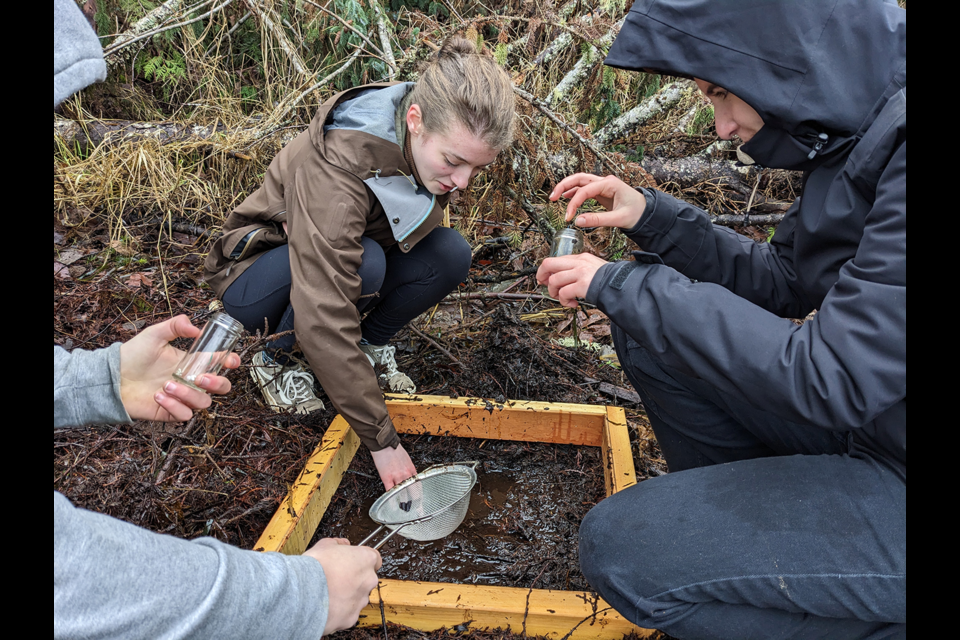Brooks Secondary School environmental science students have been engaging in what has been termed as citizen science, participating in a microplastics sampling project on qathet area beaches.
Let’s Talk Trash (LTT) team member Abby McLennan said the students went out and collected samples from three area beaches, analyzed the samples and uploaded digital images into a global database.
“This is citizen science in action,” said McLennan.
She said the students travelled as far as Okeover Inlet to collect samples and added that it continues to be the most consistently contaminated site.
“The main culprit is the styrofoam nurdles [broken down expanded polystyrene],” said McLennan.
This was the third station that they've sampled since this past fall.
McLennan said in 2022, Let's Talk Trash set up five sampling stations: Palm Beach, Second Beach, the head of Okeover Inlet, Ahygkson (formerly Harwood) Island and Savary Island.
“This work is being done in partnership with Ocean Diagnostics and we are following their sampling protocol,” said McLennan. “Each sampling station has the same 100-metre stretch measured out and four random points along the 100 metres are selected as the sampling quadrants.
“These quadrants can change each time the station is sampled but the same stretch of beach is used. Each quadrant is 0.5 by 0.5 metres and we dig down 2.5 centimetres and sieve all the sand within this area looking for microplastic. Any plastic found is then put into a jar and brought back to later be uploaded and inputted into a larger global database, which can be used to help inform future decisions and policy. Data can be used locally or at higher levels.”
Microplastic pollution is a complex problem, said Ocean Diagnostics director of communication and marketing Ashleigh Erwin.
“To stop it from entering the environment, decision-makers need more scientific data on the sources, fate and impacts of environmental microplastics,” said Erwin. We [Ocean Diagnostics] have designed the community science toolkit to empower the public to help collect the data needed to turn off the tap.
“For every microplastic particle collected in a beach survey, 13 different size, shape, colour, type and abundance data points are collected. Together, this information provides clues on the sources and impacts of local microplastic pollution and, in turn, helps to identify solutions. Our Saturna Imaging System accelerates this data analysis process and reduces human error in data reporting.”
Erwin said it is exciting and important to see collaboration among organizations, schools and decision-makers to tackle local microplastic pollution, while contributing to a larger global dataset
Graham Cocksedge is the teacher for the Brooks environment studies grade 11 and 12 class that participated in the Ocean Diagnostics data collection. He said he tries to link his classes with initiatives or projects where important learning comes through.
Cocksedge said this Ocean Diagnostics program is significant.
“We collected data that goes into a global site that can be accessed by people seeking data on climate science and environmental concerns,” said Cocksedge. “It’s impactful and definitely meaningful.
“This year, we focused on marine debris. We were all over on Ahgyskon with permission of the Tla’amin people. We did two days of beach cleanup there, which addressed a lot of issues. The students who participated presented their findings to elementary students who came here [to Brooks].”
Cocksedge said the students then participated in the Ocean Diagnostics program and learned about microplastics that are becoming more pervasive in the marine environment. He said the students are going to make a big difference in the environment and will change societal ways.
“Our future, as always, lies with our youth, the new generation,” said Cocksedge. “So, we mentor and facilitate and teach. Every generation improves on how we treat people and the environment.”
Cocksedge said he has enjoyed being part of this project.
“Any project we take on, if the kids are involved and not just learning from textbooks – if it’s a hands-on experiential learning process, I’m as excited to do it as the kids are,” said Cocksedge.
Rowan Cocksedge, a grade 11 student in the environmental science grade 11 and 12 course, said she went on all three microplastics monitoring trips that the class attended, at Palm Beach, Second Beach and Okeover Inlet.
“I helped at specific stations, sifting through sand and collecting microplastics,” said Rowan.
She said it was exciting to get out to the three sites and take part in the collection.
“We had to measure 100 metres on the beach and then pick four random numbers, where we would dig down in the sand and sift through the sand to collect microplastics,” said Rowan. “We had very clear instructions to guide us.”
Grade 12 student Tyler Zakkour said Palm Beach and Second Beach were relatively clean of microplastics, but when they conducted the search exercise at Okeover, they found microplastics. He said because the collection site was at the head of an inlet, where there was accumulated wave action, they found “a lot of stuff.”
Zakkour said the class has been putting the selected samples into a database.
“So basically, they [Ocean Diagnostics] update the database with what we found,” said Zakkour. “We provide the exact coordinates on the beach.”
Carson Mode, another Grade 12 student, said microplastics are a concern, showing up in organisms in the oceans. He said with the data collection, it is being posted so scientists can access it and monitor what is happening in the oceans.
Mode added that collecting microplastics was a great experience and that Brooks students were contributing to important research.
Join the Peak’s email list for the top headlines right in your inbox Monday to Friday.




